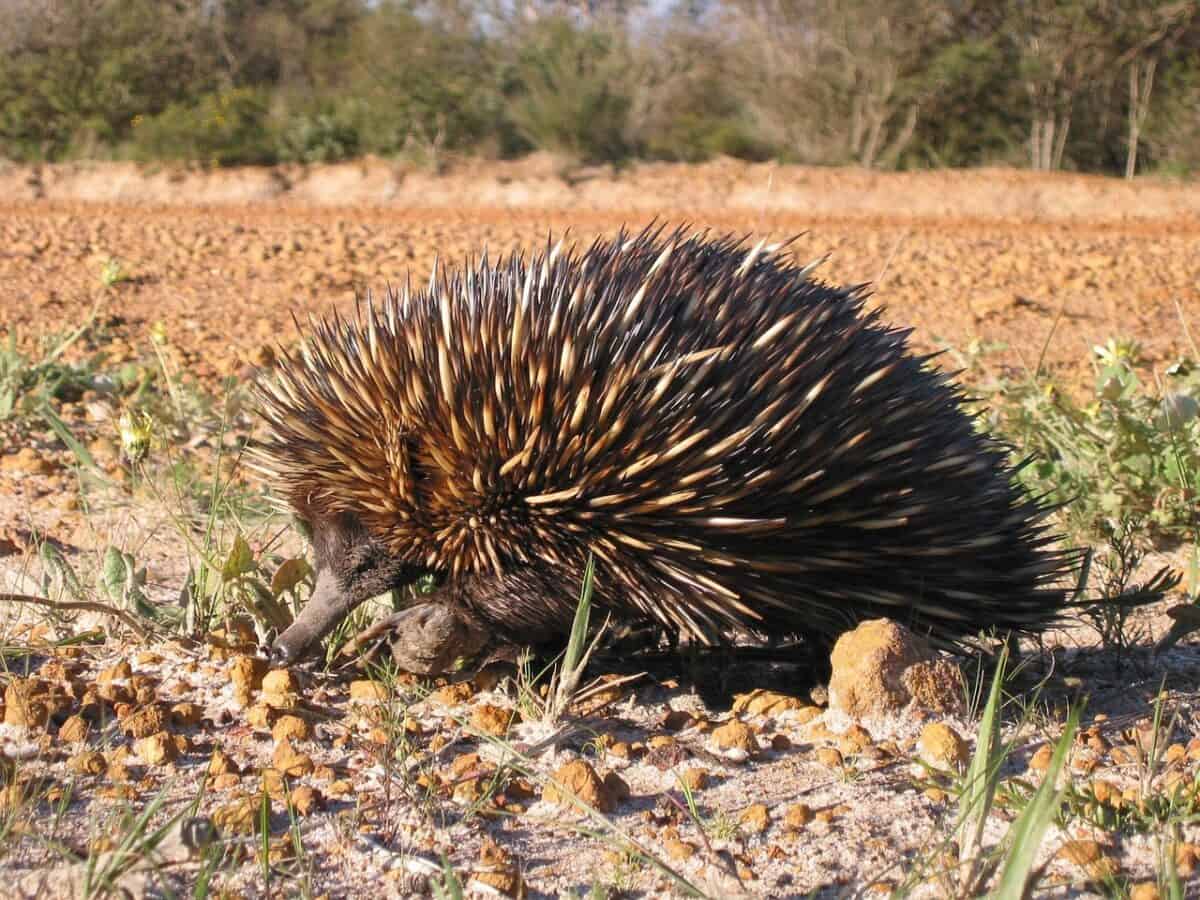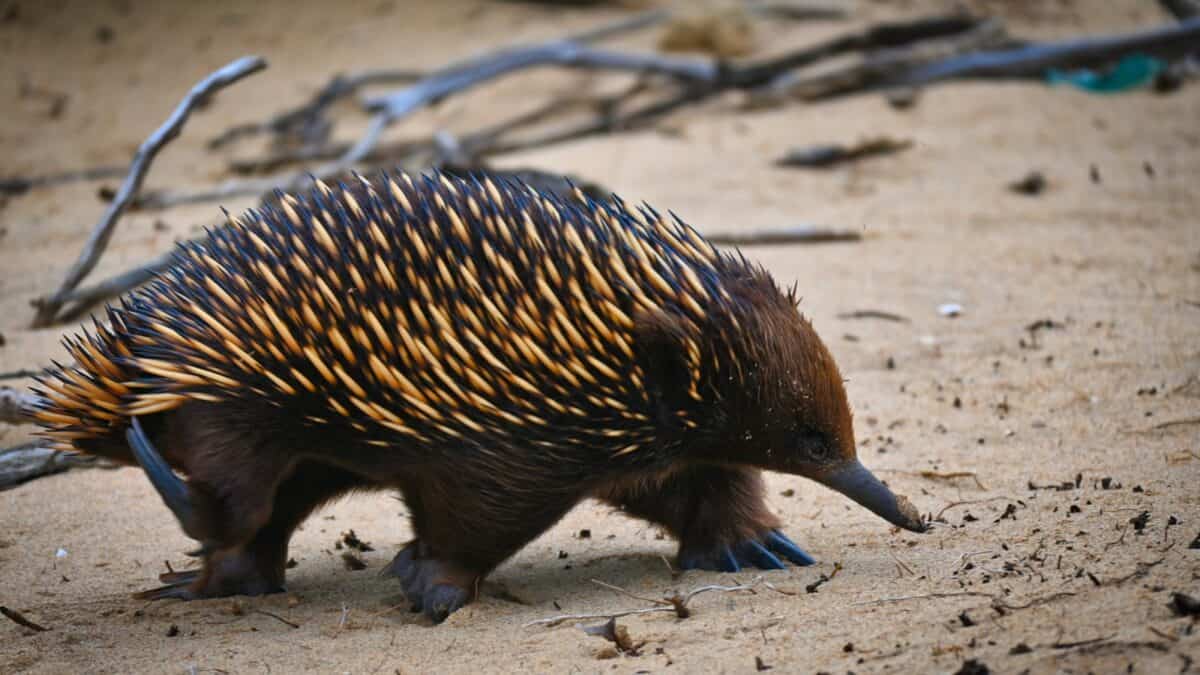In the diverse world of animal adaptations, few are as fascinating and specialized as the echidna’s use of electroreception for hunting. These spiny mammals, native to Australia and New Guinea, possess a remarkable ability that sets them apart from most other land-dwelling creatures: they can detect electrical fields generated by their prey. This sixth sense allows echidnas to locate food hidden underground or in water, making them incredibly efficient hunters despite their seemingly ungainly appearance. While electroreception is well-documented in aquatic animals like sharks and platypuses, its presence in the terrestrial echidna represents an extraordinary evolutionary adaptation that has helped these ancient creatures survive for millions of years. Let’s explore the fascinating world of echidna electroreception and discover how these peculiar animals employ this superpower to thrive in their environments.
The Unique Biology of Echidnas

Echidnas, also known as spiny anteaters, belong to the family Tachyglossidae and are classified as monotremes—mammals that lay eggs rather than giving birth to live young. Along with the platypus, they are the only surviving monotremes on Earth, representing a fascinating evolutionary lineage that diverged from other mammals approximately 200 million years ago. Four species exist today: the short-beaked echidna (Tachyglossus aculeatus) found throughout Australia and parts of New Guinea, and three species of long-beaked echidnas (genus Zaglossus) native to New Guinea. Their bodies are covered with spines similar to those of hedgehogs and porcupines, though these animals are not closely related. Beneath their spiky exterior, echidnas possess a complex biological makeup that includes several primitive characteristics alongside sophisticated adaptations like electroreception, making them living examples of evolutionary history and innovation.
Understanding Electroreception in Animals

Electroreception is the biological ability to detect electrical fields or potentials in the environment. This sensory capability operates through specialized receptors called electroreceptors, which can detect naturally occurring bioelectric fields produced by living organisms. In the animal kingdom, electroreception exists in two forms: passive and active.
Passive electroreception involves detecting the natural electrical fields generated by other animals, while active electroreception requires the animal to generate its own electrical field and then detect distortions in this field caused by nearby objects. Historically, electroreception was believed to be primarily an aquatic adaptation, as water serves as an excellent conductor of electricity. It has been well-documented in various fish species, including sharks, rays, and certain teleosts, as well as in the platypus, which uses electroreception to locate prey in murky waters. The discovery of this ability in echidnas—predominantly terrestrial animals—challenged previous assumptions about the evolution and application of this sensory modality.
The Discovery of Electroreception in Echidnas

The discovery that echidnas possess electroreceptive abilities came relatively recently in scientific history. While researchers had long known about electroreception in the platypus—the echidna’s monotreme cousin—it wasn’t until the late 1980s and early 1990s that scientists began to investigate whether echidnas might share this capability.
The breakthrough came when researchers identified electroreceptors in the snouts of echidnas, specifically in their beaks. These receptors were structurally similar to those found in platypuses but fewer in number and distributed differently. Subsequent behavioral studies confirmed that echidnas could indeed detect weak electrical fields.
This discovery was particularly significant because it represented one of the first documented cases of electroreception in a primarily terrestrial animal. The finding suggested that this sensory ability had evolved in the common ancestor of monotremes and had been retained in echidnas despite their adaptation to a largely terrestrial lifestyle, providing new insights into the evolutionary history of sensory systems in early mammals.
Anatomy of Echidna Electroreceptors

The electroreceptors of echidnas are concentrated in their elongated, sensitive snouts. These specialized sensory organs, known as mucous glands, are located in the skin of the echidna’s beak. Each short-beaked echidna possesses approximately 400-2,000 electroreceptors, significantly fewer than the 40,000 found in their platypus relatives but still substantial enough to provide effective electroreception.
These receptors are modified mucous glands that connect to the external environment through tiny pores in the skin. Internally, they are innervated by branches of the trigeminal nerve (the fifth cranial nerve), which transmits the electrical signals to the brain for processing.
The structure of these electroreceptors includes specialized epithelial cells that are sensitive to electrical stimuli as low as 1.8 mV/cm—a remarkable level of sensitivity that allows echidnas to detect the minute electrical fields generated by the muscular contractions of their prey. While the electroreceptors are structurally similar to those found in platypuses, they’ve been adapted to function in the drier conditions of terrestrial environments, demonstrating how this sensory system has evolved to meet the echidna’s specific ecological needs.
How Echidnas Detect Electrical Fields

The process by which echidnas detect electrical fields involves a sophisticated interplay between their specialized snout and nervous system. When an echidna forages, it sweeps its moist, sensitive beak across the soil or substrate, often probing into crevices and under objects. This moisture is crucial, as it provides the conductive medium necessary for electroreception to function efficiently in a terrestrial environment.
As the beak comes near an organism generating bioelectric fields—such as an earthworm, insect larva, or termite—the echidna’s electroreceptors detect these minute electrical signals. The moisture on the snout and the saliva the echidna applies while foraging create a conductive path between the prey’s electrical field and the electroreceptors. Once detected, these electrical signals trigger neural responses that are transmitted via the trigeminal nerve to the brain’s somatosensory cortex.
Research indicates that echidnas can detect electrical fields as weak as 1.8 millivolts per centimeter, allowing them to precisely locate prey even when it’s completely hidden from sight. This sensory capability works in conjunction with their acute sense of smell and tactile sensitivity, creating a multi-modal hunting approach that makes echidnas remarkably efficient predators despite their slow movement and seemingly cumbersome build.
Hunting Strategies of Electroreceptive Echidnas

Echidnas employ a methodical hunting strategy that capitalizes on their electroreceptive capabilities. When foraging, they adopt a systematic search pattern, moving slowly while continuously probing the ground with their sensitive snouts. The echidna’s hunting process typically begins with olfactory detection—using their well-developed sense of smell to identify general areas where prey might be present.
Once a promising location is identified, they switch to more precise methods, using their electroreceptors to pinpoint the exact position of hidden prey. This dual-sensory approach allows them to first detect the chemical signatures of potential food sources and then use electroreception for the final, precise localization. When prey is detected, echidnas use their powerful forelimbs to dig rapidly, creating access to subterranean prey.
Their long, sticky tongues—which can extend up to 18 centimeters—then dart in and out at remarkable speeds of up to 100 times per minute to capture prey. Interestingly, research has shown that echidnas will preferentially target certain areas based on electrical signals, even in the absence of olfactory cues, demonstrating the primacy of electroreception in their final hunting decisions. This sophisticated hunting strategy allows echidnas to exploit food resources that remain inaccessible to many other predators, giving them a significant competitive advantage in their ecological niche.
Primary Prey Detected Through Electroreception

Echidnas primarily target invertebrate prey that generate bioelectric fields detectable through electroreception. Their diet consists largely of ants and termites, earning them the common name “spiny anteaters,” but they also consume earthworms, beetle larvae, and various other soil-dwelling invertebrates.
These prey animals produce electrical fields through their muscular contractions, nervous system activity, and other physiological processes, creating bioelectric signatures that echidnas can detect. Earthworms, for example, generate electrical fields of approximately 1-2 millivolts as they move through soil, well within the detection range of an echidna’s electroreceptors. Termites and ants, while smaller, exist in colonies that collectively produce detectable electrical activity. The most electrically active prey, particularly earthworms and various larvae, appear to be preferentially targeted when echidnas employ electroreception.
Research has demonstrated that echidnas can distinguish between dead insects (which produce no electrical field) and live ones, even when both are hidden from view, highlighting the importance of bioelectric detection in their foraging strategy. This specialized diet of invertebrates that often live underground or within wood has driven the evolution of the echidna’s electroreceptive capabilities, allowing them to effectively exploit this ecological niche with minimal competition from other predators.
Comparison with Platypus Electroreception

While both echidnas and platypuses possess electroreception, there are significant differences in how this sensory system has evolved in these monotreme cousins. The platypus has a far more developed electroreceptive system, with approximately 40,000 electroreceptors concentrated in the soft skin of its bill, compared to the echidna’s 400-2,000 receptors.
This difference reflects their divergent ecological adaptations—the platypus is semi-aquatic and uses electroreception extensively while hunting underwater, where electrical signals propagate more efficiently than in air or soil. The platypus also employs active electroreception during hunting, closing its eyes, ears, and nostrils underwater and relying almost exclusively on detecting the electrical fields generated by the muscular contractions of prey like crustaceans, fish eggs, and insect larvae. In contrast, echidnas use electroreception as part of a multi-sensory approach to foraging, combining it with their acute sense of smell and tactile sensitivity.
The neural pathways for processing electroreceptive information also differ between the two animals, with the platypus showing more specialized and extensive brain regions dedicated to electroreception. These differences highlight how similar sensory capabilities can be adapted to different ecological niches, with the platypus evolving a highly specialized aquatic electroreceptive system while the echidna has developed a modified version suited to terrestrial foraging.
Evolutionary Significance of Terrestrial Electroreception

The presence of electroreception in echidnas holds profound implications for our understanding of sensory evolution in mammals. Since monotremes represent the earliest branch of mammalian evolution, having diverged from the lineage leading to marsupials and placental mammals approximately 200 million years ago, their sensory capabilities provide a window into ancestral mammalian traits. The fact that both extant monotreme families—echidnas and platypuses—possess electroreception suggests that this sense was likely present in their common ancestor and therefore may have been a feature of early mammals.
This challenges previous assumptions that electroreception evolved primarily as an adaptation to aquatic environments. Instead, it suggests that early mammals may have possessed this sensory capability, which was subsequently lost in most lineages but retained in monotremes. The echidna’s terrestrial electroreception represents a remarkable case of sensory exaptation—where a trait evolved for one purpose is repurposed for another—as electroreception likely originated in an aquatic context but was maintained and adapted for terrestrial use in echidnas. This evolutionary history provides valuable insights into the sensory worlds of extinct mammalian ancestors and demonstrates the remarkable plasticity of sensory systems in adapting to different ecological contexts throughout evolutionary history.
Research Challenges and Technological Applications

Studying electroreception in echidnas presents unique challenges that have limited our understanding of this fascinating sensory ability. Unlike aquatic animals, where electroreception can be tested in controlled water environments, creating experimental setups for terrestrial electroreception requires innovative approaches.
Researchers have had to develop specialized equipment to generate and measure electrical fields in soil and other substrates at the minute levels relevant to echidna foraging. Additionally, echidnas are notoriously difficult research subjects—they’re shy, stress easily in captivity, and their specialized diet makes long-term maintenance challenging. Despite these obstacles, ongoing research continues to reveal new insights, particularly through non-invasive observational studies and advances in neuroimaging techniques. The study of echidna electroreception has also inspired technological innovations.
Engineers have developed biomimetic sensors based on monotreme electroreception that can detect weak electrical fields in various media. These bio-inspired technologies have applications in environmental monitoring, non-destructive testing of structures, and even medical devices. For instance, sensors inspired by echidna snouts are being developed to detect bioelectric signals in patients non-invasively. As research techniques improve, our understanding of echidna electroreception will likely expand, potentially leading to further technological applications that mimic this remarkable natural sensing system.
Conservation Implications and Threats

Understanding the electroreceptive abilities of echidnas has important implications for their conservation. As these animals rely on detecting minute electrical fields for hunting, they may be particularly vulnerable to electromagnetic pollution—the proliferation of artificial electromagnetic fields from power lines, telecommunications, and other human infrastructure.
While research on this specific threat remains limited, there is growing concern that anthropogenic electromagnetic fields might interfere with the echidna’s ability to locate prey effectively. Habitat destruction poses another significant threat, particularly when it involves soil compaction or alteration of soil moisture levels, both of which could potentially impact the efficacy of electroreception. The short-beaked echidna is currently listed as Least Concern on the IUCN Red List, but all three species of long-beaked echidnas from New Guinea are classified as either Critically Endangered or Vulnerable due to hunting and habitat loss.
Conservation strategies for echidnas should consider their specialized sensory needs, potentially including buffer zones around critical habitat to minimize electromagnetic interference and preservation of soil conditions conducive to effective electroreception. By protecting these unique sensory specialists, we not only preserve a fascinating evolutionary adaptation but also maintain the ecological services echidnas provide through their control of insect populations and soil aeration during foraging.
Conclusion: The Remarkable Sensory World of Echidnas

The electroreceptive abilities of echidnas represent one of nature’s most fascinating sensory adaptations, allowing these spiny monotremes to perceive their environment in ways fundamentally different from most other terrestrial animals. By detecting the minute electrical signals generated by prey hidden underground or in logs, echidnas have evolved a specialized hunting strategy that grants them access to food resources unavailable to most competitors.
This remarkable capability, shared only with their monotreme cousin the platypus among mammals, provides a living window into the sensory world of early mammalian ancestors and demonstrates how ancient sensory modalities can be adapted to new ecological contexts. As research continues to unravel the complexities of echidna electroreception, we gain not only a deeper appreciation for these unique animals but also insights that may inspire new technologies and inform conservation strategies. In protecting echidnas and the environments that support their specialized sensory systems, we preserve living examples of evolutionary history that continue to challenge our understanding of sensory perception and adaptation in the animal kingdom.
- 15 Emotional Service Dog Stories That Prove Dogs Are More Than Just Pets - August 20, 2025
- How the Global Pet Trade Is Threatening Exotic Animals in the Wild - August 20, 2025
- Crocodiles Are Closer to Dinosaurs Than Birds - August 20, 2025

